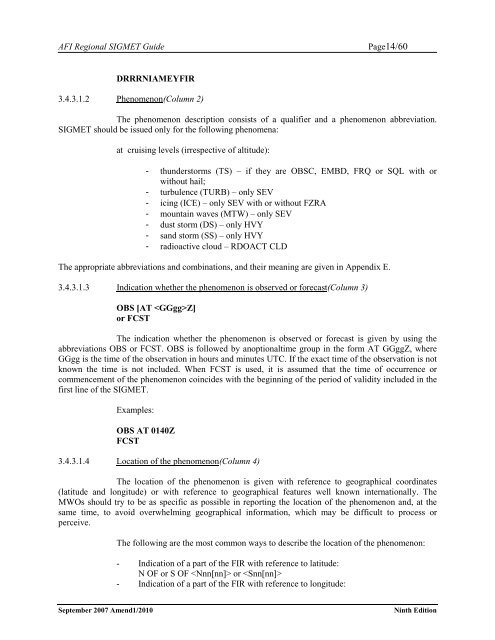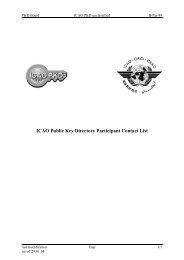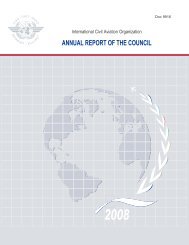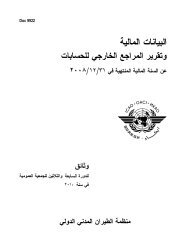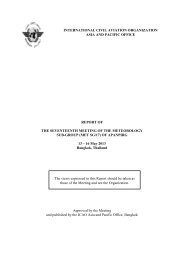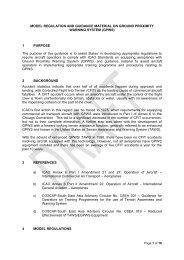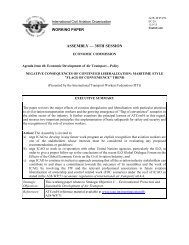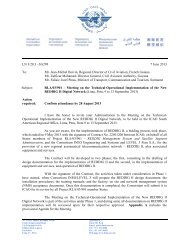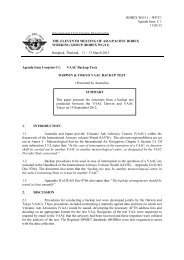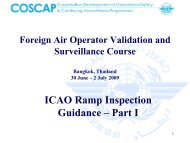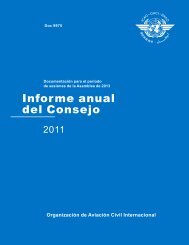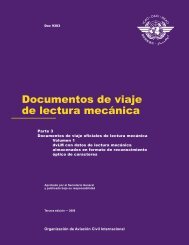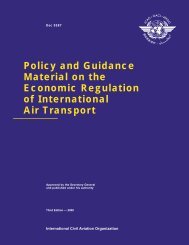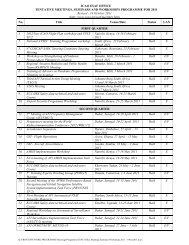- Page 1 and 2:
Appendix A -List of Participants N
- Page 3 and 4:
19 Sougue Bissa Chargé d’Activit
- Page 5 and 6:
Conc/Dec No. Title of Conclusion/ D
- Page 7 and 8:
Conc/Dec No. 13) APIRG Con. 14/42 1
- Page 9 and 10:
Conc/Dec No. 21) APIRG Con16/58 22)
- Page 11 and 12:
Conc/Dec No. 29) APIRG/17 Concl. 17
- Page 13 and 14:
Conc/Dec No. 36) APIRG/17 Concl. 17
- Page 15 and 16:
MET/SG/10 Report - Appendix C INTER
- Page 17 and 18:
AMBEX HANDBOOK 7th Ed. 3/58 Amendme
- Page 19 and 20:
AMBEX HANDBOOK 7th Ed. 5/58 8. META
- Page 21 and 22:
AMBEX HANDBOOK 7th Ed. 7/58 1. INTR
- Page 23 and 24:
AMBEX HANDBOOK 7th Ed. 9/58 2.4.2 U
- Page 25 and 26:
AMBEX HANDBOOK 7th Ed. 11/58 3. DEF
- Page 27 and 28:
AMBEX HANDBOOK 7th Ed. 13/58 4.3.1.
- Page 29 and 30:
AMBEX HANDBOOK 7th Ed. 15/58 5.5 Re
- Page 31 and 32:
AMBEX HANDBOOK 7th Ed. 17/58 6. TAF
- Page 33 and 34:
AMBEX HANDBOOK 7th Ed. 19/58 6.2.8
- Page 35 and 36:
AMBEX HANDBOOK 7th Ed. 21/58 TAF DG
- Page 37 and 38:
AMBEX HANDBOOK 7th Ed. 23/58 7. SPE
- Page 39 and 40:
AMBEX HANDBOOK 7th Ed. 25/58 8.2.4
- Page 41 and 42:
AMBEX HANDBOOK 7th Ed. 27/58 9. EXC
- Page 43 and 44:
AMBEX HANDBOOK 7th Ed. 29/58 11. IN
- Page 45 and 46:
AMBEX HANDBOOK 7th Ed. 31/58 inform
- Page 47 and 48:
AMBEX HANDBOOK 7th Ed. 33/58 AMBEX
- Page 49 and 50:
AMBEX HANDBOOK 7th Ed. 35/58 AMBEX
- Page 51 and 52:
AMBEX HANDBOOK 7th Ed. 37/58 AMBEX
- Page 53 and 54:
AMBEX HANDBOOK 7th Ed. 39/58 AMBEX
- Page 55 and 56:
AMBEX HANDBOOK 7th Ed. 41/58 NOC AA
- Page 57 and 58:
AMBEX HANDBOOK 7th Ed. 43/58 with t
- Page 59 and 60:
AMBEX HANDBOOK 7th Ed. 45/58 APPEND
- Page 61 and 62:
AMBEX HANDBOOK 7th Ed. 47/58 WMO HE
- Page 63 and 64:
AMBEX HANDBOOK 7th Ed. 49/58 MWO Lo
- Page 65 and 66:
AMBEX HANDBOOK 7th Ed. 51/58 1.1.3
- Page 67 and 68:
AMBEX HANDBOOK 7th Ed. 53/58 1.1.5
- Page 69 and 70:
AMBEX HANDBOOK 7th Ed. 55/58 Vbul c
- Page 71 and 72:
AMBEX HANDBOOK 7th Ed. 57/58 TABLE
- Page 73 and 74:
AMBEX HANDBOOK 7th Ed. 59/58 saidou
- Page 75 and 76:
ANNEX 1 - AFI MET/SG/10 Report - Ap
- Page 77 and 78:
MET/SG/10 Report - Appendix D AFI -
- Page 79 and 80:
MET/SG/10 Report - Appendix D AFI -
- Page 81 and 82:
MET/SG/10 Report - Appendix D AFI -
- Page 83 and 84:
ANNEX 1 - ASIA/PAC MET/SG/10 Report
- Page 85 and 86:
MET/SG/10 Report - Appendix D ASIA/
- Page 87 and 88:
MET/SG/10 Report - Appendix D Name
- Page 89 and 90:
MET/SG/10 Report - Appendix D ASIA/
- Page 91 and 92:
MET/SG/10 Report - Appendix D ASIA/
- Page 93 and 94:
MET/SG/10 Report - Appendix D CAR/S
- Page 95 and 96:
MET/SG/10 Report - Appendix D CAR/S
- Page 97 and 98:
MET/SG/10 Report - Appendix D CAR/S
- Page 99 and 100:
MET/SG/10 Report - Appendix D CAR/S
- Page 101 and 102:
MET/SG/10 Report - Appendix D EUR -
- Page 103 and 104:
MET/SG/10 Report - Appendix D EUR -
- Page 105 and 106:
MET/SG/10 Report - Appendix D EUR -
- Page 107 and 108:
MET/SG/10 Report - Appendix D EUR -
- Page 109 and 110: MET/SG/10 Report - Appendix D EUR -
- Page 111 and 112: MET/SG/10 Report - Appendix D EUR -
- Page 113 and 114: MET/SG/10 Report - Appendix D EUR -
- Page 115 and 116: MET/SG/10 Report - Appendix D EUR -
- Page 117 and 118: MET/SG/10 Report - Appendix D EUR -
- Page 119 and 120: MET/SG/10 Report - Appendix D MID -
- Page 121 and 122: MET/SG/10 Report - Appendix D NAM -
- Page 123 and 124: MET/SG/10 Report - Appendix D NAM -
- Page 125 and 126: MET/SG/10 Report - Appendix D NAM -
- Page 127 and 128: MET/SG/10 Report - Appendix D NAM -
- Page 129 and 130: MET/SG/10 Report - Appendix D NAM -
- Page 131 and 132: MET/SG/10 Report - Appendix D NAM -
- Page 133 and 134: ANNEX 1 - NAT MET/SG/10 Report - Ap
- Page 135 and 136: ANNEX 2 - AFI MET/SG/10 Report - Ap
- Page 137 and 138: ANNEX 2 - EUR MET/SG/10 Report - Ap
- Page 139 and 140: MET/SG/10 Report - Appendix D State
- Page 141 and 142: ANNEX 2 - CAR/SAM MET/SG/10 Report
- Page 143 and 144: ANNEX 2 - NAM MET/SG/10 Report - Ap
- Page 145 and 146: ANNEXE 3 MET/SG/10 Report - Appendi
- Page 147 and 148: MET/SG/10 Report - APPENDIX E INTER
- Page 149 and 150: AFIAFI Regional SIGMET Guide Page3/
- Page 151 and 152: AFIRegional SIGMET Guide Page5/60 1
- Page 153 and 154: AFI Regional SIGMET Guide Page 7/60
- Page 155 and 156: AFI Regional SIGMET Guide Page 9/60
- Page 157 and 158: AFI Regional SIGMET Guide Page 11/6
- Page 159: AFI Regional SIGMET Guide Page 13/6
- Page 163 and 164: AFI Regional SIGMET Guide Page 17/6
- Page 165 and 166: AFI Regional SIGMET Guide Page 19/6
- Page 167 and 168: AFI Regional SIGMET Guide Page 21/6
- Page 170 and 171: AFI Regional SIGMET Guide Page22/60
- Page 172 and 173: AFI Regional SIGMET Guide Page24/60
- Page 174 and 175: AFI Regional SIGMET Guide Page26/60
- Page 176 and 177: AFI Regional SIGMET Guide Page28/60
- Page 178 and 179: AFI Regional SIGMET Guide Page 30/6
- Page 180 and 181: AFI Regional SIGMET Guide Page 32/6
- Page 182 and 183: AFI Regional SIGMET Guide Page 34/6
- Page 184 and 185: AFI Regional SIGMET Guide Page 36/6
- Page 186 and 187: AFI Regional SIGMET Guide Page 38/6
- Page 189 and 190: AFI Regional SIGMET Guide Page 37/6
- Page 191: AFI Regional SIGMET Guide Page 39/6
- Page 194 and 195: AFI Regional SIGMET Guide Page 42/6
- Page 196 and 197: AFI Regional SIGMET Guide Page 44/6
- Page 198 and 199: AFI Regional SIGMET Guide Page 46/6
- Page 200 and 201: AFI Regional SIGMET Guide Page 48/6
- Page 202 and 203: AFI Regional SIGMET Guide Page 50/6
- Page 204 and 205: AFI Regional SIGMET Guide Page 52/6
- Page 206 and 207: AFI Regional SIGMET Guide Page 54/6
- Page 208 and 209: ICAO Location Indicator SA SP FC FT
- Page 210 and 211:
Appendix H SUMMARY OF OPERATIONAL S
- Page 212 and 213:
STAT E CAMEROON CAPE VERDE Requirem
- Page 214 and 215:
STATE CHAD COMOROS Requirements Ide
- Page 216 and 217:
STATE DJIBOUTI Requirements 1 Ident
- Page 218 and 219:
STATE THE GAMBIA Requirements Ident
- Page 220 and 221:
STATE GHANA GUINEA Requirements Ide
- Page 222 and 223:
STATE GUINEA BISSAU LESOTHO Require
- Page 224 and 225:
STATE LIBERIA Requirements Identifi
- Page 226 and 227:
STAT E MAURITANIA NIGER Requirement
- Page 228 and 229:
STA TE Requirements 1 Identificatio
- Page 230 and 231:
ETAT 1 SAO TOME SÉNÉGAL Besoins I
- Page 232 and 233:
ETAT 1 SIERRA LEONE SOMA LIA SWAZI
- Page 234 and 235:
APIRG/15-WP/13 27/06/05 24 EXPLANAT
- Page 236 and 237:
c) Review and update the AFI Volcan
- Page 238 and 239:
Page 2 of 29 Volcanic Ash Contingen
- Page 240 and 241:
Page 4 of 29 Volcanic Ash Contingen
- Page 242 and 243:
. Page 6 of 29 Volcanic Ash Conting
- Page 244 and 245:
Page 8 of 29 Volcanic Ash Contingen
- Page 246 and 247:
Page 10 of 29 Volcanic Ash Continge
- Page 248 and 249:
Page 12 of 29 Volcanic Ash Continge
- Page 250 and 251:
Page 14 of 29 Volcanic Ash Continge
- Page 252 and 253:
Page 16 of 29 Volcanic Ash Continge
- Page 254 and 255:
Page 18 of 29 Volcanic Ash Continge
- Page 256 and 257:
3.6 Risk Tolerability Page 20 of 29
- Page 258 and 259:
Page 22 of 29 Volcanic Ash Continge
- Page 260 and 261:
No. HAZARD Descriptio n (additional
- Page 262 and 263:
F) SFC G) FL350) Page 26 of 29 Volc
- Page 264 and 265:
Page 28 of 29 Volcanic Ash Continge
- Page 266 and 267:
World area forecast system (WAFS) (
- Page 268 and 269:
Terms of Reference Appendix M: Term
- Page 270 and 271:
3 Task Source Recent Progress Next


